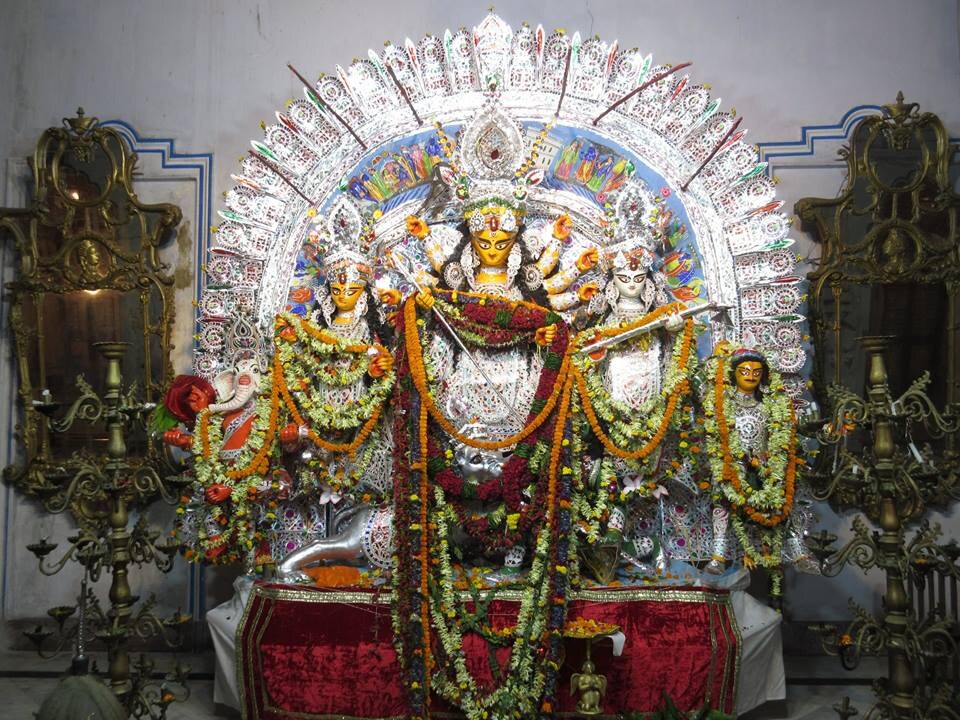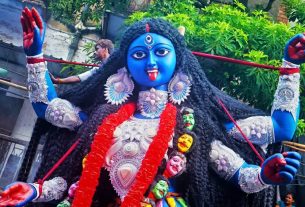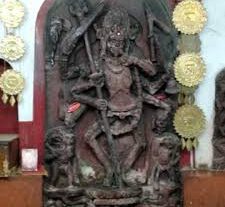Nestled in the historic lanes of North Kolkata, Sovabazar Rajbari Durga Puja 2024 held aloft its heritage with 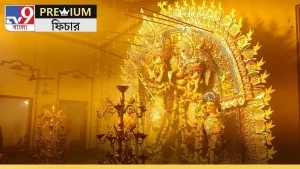 quiet dignity and cultural richness. For centuries, this aristocratic family celebration—launched in 1757 by Maharaja Nabakrishna Deb—has served as a beacon of tradition, carrying forward rituals unchanged while remaining a symbol of Kolkata’s deep-rooted past. This year, it marked its 267th edition, steeped in history yet personifying timeless devotion and grace.
quiet dignity and cultural richness. For centuries, this aristocratic family celebration—launched in 1757 by Maharaja Nabakrishna Deb—has served as a beacon of tradition, carrying forward rituals unchanged while remaining a symbol of Kolkata’s deep-rooted past. This year, it marked its 267th edition, steeped in history yet personifying timeless devotion and grace.
A Legacy Etched in Time
Founded post-Battle of Plassey in 1757, the Puja at Sovabazar Rajbari is the oldest Bonedi Bari Puja in the city, where dignitaries like Lord Clive and Warren Hastings once graced the festivities. Over time, it became a hallmark of aristocratic pride and cultural prowess. The Chotto Rajbari, built for Nabakrishna’s son, added to the Puja’s splendor. In the vast courtyard of the Thakur Dalan, divine celebrations unfolded with grandeur and grace.
Simplicity is the Signature
Unlike the modern pandals aglow with novelty, Sovabazar Rajbari focuses on heritage over hype. Its ekchala idol—unchanged in structure year after year—follows the traditional style: a single roofed backdrop known as Sabeki. What makes it even more special is the Daker Saj, ornate silver foil attire imported from Germany via 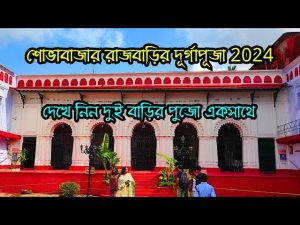 postal mail—hence “Daker” (post)—thoughtfully maintained across centuries. The idol is uniquely adorned as Ghotokmuki Singha, with a lion’s body and a horse’s face—a rare symbol distinguishing this Puja from all others.
postal mail—hence “Daker” (post)—thoughtfully maintained across centuries. The idol is uniquely adorned as Ghotokmuki Singha, with a lion’s body and a horse’s face—a rare symbol distinguishing this Puja from all others.
Rich Rituals Woven in Tradition
Sovabazar Puja remains steeped in rituals passed down through generations:
-
Kathamo Puja marks the ritual worship of the palace structure itself.
-
Kalabou Snan: On Saptami morning, a procession takes the Kalabou (banana stalk) to the Ganges for ceremonial bathing, accompanied by soulful songs and a vivid red velvet umbrella.
-
Sandhi Puja: Once heralded by cannon fire, now with blank shots, marking powerful transitions amid silence.
-
Konkanjali: On Dashami, married women offer symbolic plates of gold, silver sindoor, and rice. The deity is placed on a ladder, and devotees cast these offerings, marking sacred farewells.
The unique Nilkantha bird ritual, once involving live birds, now takes a symbolic turn with molded clay replicas, respecting wildlife laws.
The Grand Visarjan
Sovabazar’s Vijaya Dashami immersion blends solemnity and pageantry. The nerve center is the courtyard, where the idol is carried onto two boats, gently drifting apart until the Devi is immersed in the Hooghly River. The ceremonial release of clay Nilkantha birds—emblems of Maa Durga’s departure—marks the end of worship in regal simplicity.
A Feast Fit for the Divine
Durga Puja here is not just spiritual—it’s a culinary tradition. The Rajbari is famous for its mitha bhog—ten to 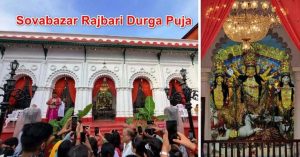 twelve varieties of sweets offered to the Goddess, ranging from red laddus to snow-like motichoor, chowk gaja, pantuwa, and oversized jilipi. Crisp nimbu kachuri and nimki add savory flair. Noteworthy is the absence of non-vegetarian offerings—even fish—is traditionally avoided, elevating purity and sentiment.https://www.pujo2pujo.com
twelve varieties of sweets offered to the Goddess, ranging from red laddus to snow-like motichoor, chowk gaja, pantuwa, and oversized jilipi. Crisp nimbu kachuri and nimki add savory flair. Noteworthy is the absence of non-vegetarian offerings—even fish—is traditionally avoided, elevating purity and sentiment.https://www.pujo2pujo.com
Royal Aesthetic in Every Detail
As twilight descends, the famous Belgian crystal chandeliers illuminate the courtyard, casting dancing reflections on heritage walls. The ambiance is one of regal serenity—intimate yet majestic, where silence speaks volumes and faith shines brighter than lights.
Cultural Confluence in Regal Walls
Beyond Puja, Sovabazar Rajbari has etched its place in history. Icons such as Raja Ram Mohan Roy, Rabindranath Tagore, Sri Ramakrishna, Sister Nivedita, and Swami Vivekananda walked its lanes or were honored in its courtyard following his return from Chicago in 1897.The walls resonate with echoes of Bengal Renaissance discourse and spiritual awakening.
Visitor’s Guide: How to Experience It
-
Timings & Access: Daily from 8 AM–8 PM, free entry.
-
Dress Code: Modest and respectful attire is recommended to match the serene setting.
-
Best Time to Visit: Shashthi or early morning on any day, to absorb sacred rituals calmly.
-
Food: Indulge in the bhog’s delicacies, served within the courtyard—each bite tinged with nostalgia.
-
Pathways: Accessible from Shovabazar Metro, and a short walk leads through heritage lanes.
Reflections on Sovabazar’s Enduring Brilliance
The Sovabazar Rajbari Durga Puja is more than a festival—it’s a living museum of tradition, where every custom is a brushstroke in a timeless painting. In a city enamored with innovation, it stands majestically s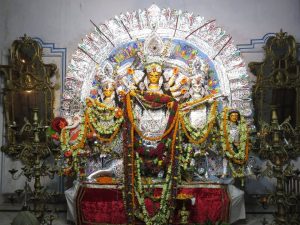 ilent, reminding us that spiritual beauty lies not in novelty, but in preservation. Every year, it reaffirms that Durga Puja is not just a celebration—it is heritage, legacy, and the immortal heartbeat of Kolkata.
ilent, reminding us that spiritual beauty lies not in novelty, but in preservation. Every year, it reaffirms that Durga Puja is not just a celebration—it is heritage, legacy, and the immortal heartbeat of Kolkata.
As the Devi journeys back to Ganesh Ghat on her twin boats, and clay Nilkanthas rise into the sky, one cannot help but be moved by the poignant elegance of a Puja that remains poised on history’s shoulders. Sovabazar Rajbari doesn’t just celebrate Durga Puja—it guards 267 years of devotion, dignity, and culture.

